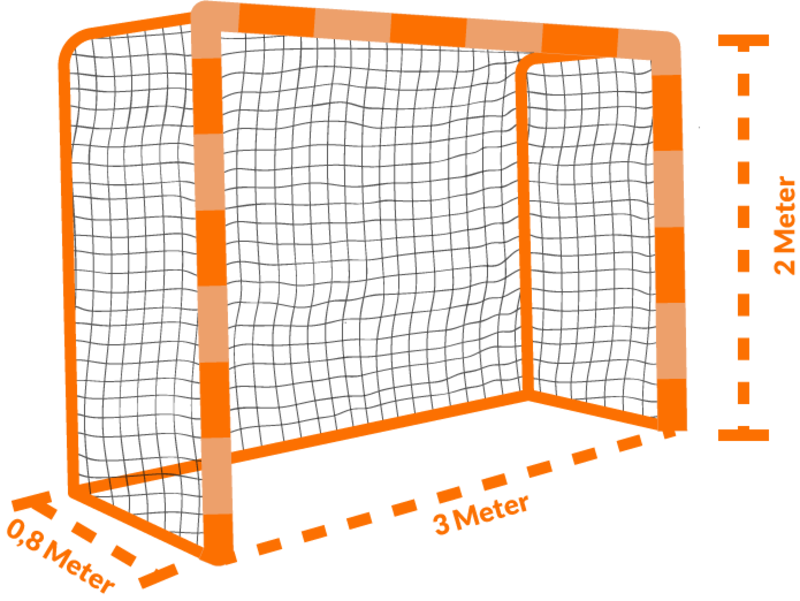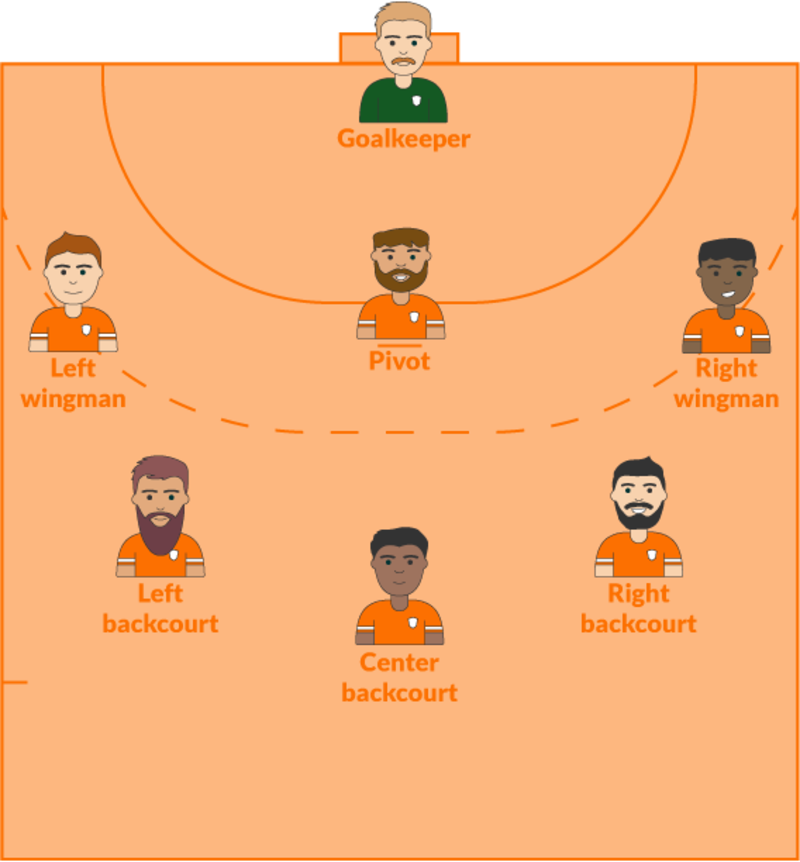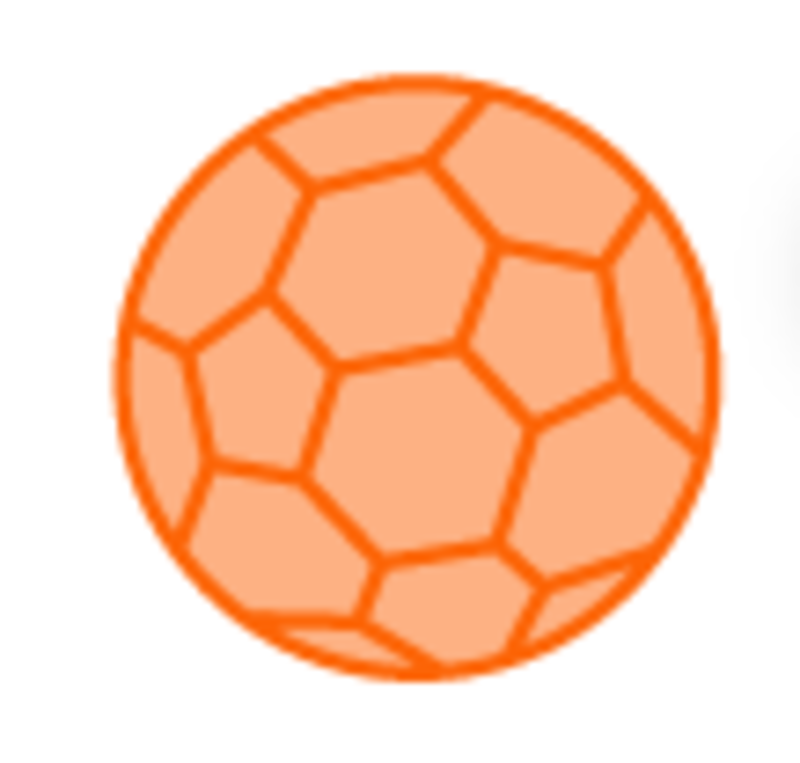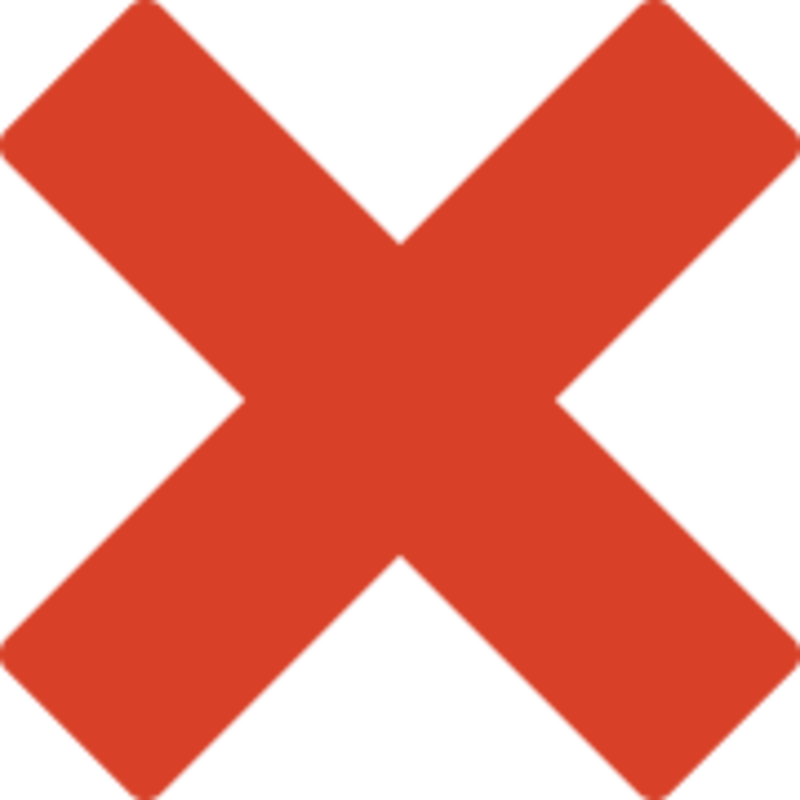Handball rules: How to play handball
What is handball?
Handball is a popular indoor game, consisting of two teams, competing to see who can score the most goals, by throwing the ball into the competing teams goal, in a match. The rules of handball varies a bit, depending on whether you are playing on elite level or the lower levels. Both versions of the rules will be addressed in this article. Most of the rules are the same for both, when they differentiate, it will be explained.
The court
Most gym and sport halls are big enough to house a handball court, which always is 40 x 20 meters, as show in the picture. The court is split into two big halves, each of which is marked with lines to indicate how close the player can come to the opposition's goal, and also to show the area in which the goalkeeper is allowed to use his or her entire body to defend against a potential goal.


The teams

- Each team consists of 7 players (normally 6 on the court and 1 guarding the goal) plus substitutional players
- The goalkeepers job is to prevent players on the opposite team from scoring goals. As the only player on the team, the goalkeeper is allowed to touch the ball with his or her feet, however only within the goal area. The goalkeeper is allowed to leave the goal area.
- The job of the on court players is to defend whenever the opposing team has the ball, and to try and score when their own team has the ball.
- On court players are not allowed to step into the goal area
- The goal keeper and on court players are not allowed to wear the same colors of clothes
- Fluid substitutions are always allowed, however there can never be more than seven players from one team on the court at once (will be punished with suspension)
- It is allowed to take out the goalkeeper and to play with seven on court players
- An on court player can play as an acting goalkeeper if the player wears coveralls in the same colors as the goalkeeper
TIP: Read about our free membership management software
Game time
Regulation:
- The length of a game can vary depending on the age of the players. Normally it is:
- Players between 8 and 12 years: 40 minutes (2 x 20 min)
- Players between 12 and 16 years: 50 minutes (2 x 25 min)
- Players over 16 years: 60 minutes (2 x 30 min)
- The break between the two halves are always 10 minutes.
Stoppage in the game:
The game clock is paused:
- When a player is suspended/disqualified
- When the coach used the time out card (both team coaches gets a small break in the game to go over tactics). Time outs can only be used when your team is in possession of the ball. Each team has one time out in each half of the game and none in potential overtime (3 in the entire game on the elite level)
- When the time keeper / judges blows the whistle
- The referees usually decides when the time is stopped and started again
- It is allowed to substitute players in and out at game breaks, but not during time outs
Overtime
- Happens during finals, when no winner has been found during the end of regulation (equal amount of goals scored)
- 5 minutes break after the end of regulation
- 5 minutes of playing time during the first half of overtime
- Followed by a 1 minute break
- 5 minutes of playing time during the second half of overtime
- If the game is still tied after 70 minutes: Another first half of 5 minutes are played
- Followed by a one minute break
- And then followed by 5 minutes, making up for the second half
Penalty shootout
- If the game is still tied after overtime, the game will be decided in a competition of Seven-meter throws, where each team will shoot for goal, one player at the time.
- 5 players are selected to throw for each team. It is allowed to replace the goalkeeper (the goalkeeper is also allowed to throw for goal)
- Is the score still tied after 5 throws buy each team, the shootout continues until one team has more goals than the other, on the same amount of throws (one throw at the time from each team)
- Suspended players are not allowed to the part in the shootout
Try Sportmember for Free - Create profile
The ball

A handball is a round ball, made from leather or a carbon sleeve. The surface must not me shiny or slippery, since the players need to be able to catch the ball with one hand. The size of the ball differentiates, depending on the age of the players:
- 50-52 cm (size 1): Boys from 8 to 12 years - Girls from 8 to 14 years
- 54-56 cm (size 2): Boys from 12 to 16 years - Girls over 14 years + seniors
- 58-60 cm (size 3): Boys over 16 years (seniors)
Walking and free-throw
In handball it is allowed to:

- Take a maximum of 3 steps with the ball, without doing a dribble. After a dribble you are again allowed to take a maximum of 3 steps.
- Touch the ball with the hands, the arms, the shoulders, the head, the stomach, thigh and knee (on court players)
- Touch the ball with all body parts (Goalkeeper)
- Stand still with the ball for a maximum of 3 seconds (without throwing or dribbling)
- Make a screening using your body to stand in the way of the opposition, opening a gap for a teammate to get through the defense and take a shot at the goal.
In handball it is not allowed to:

- Take more than 3 steps without doing a dribble
- Do a “Double dribble” (Doing a new dribble after already dribbling once and then holding the ball in their hands)
- Touch the ball with the foot or the lower part of the leg
- Rip the ball out of the hands of an opposing player in possession of the ball
- To push og rip an opposing player away with the use of the hands, elbows etc.
- Stand still with the ball for more then 3 seconds (without throwing or dribbling)
When does a score count as a goal?
For a goal to count, the entire ball has to cross the goalline, and the scoring team cannot have committed an infraction or rule violation in the attempt to score. These infractions are called “attack errors”.
When attempting to score a goal by jumping into the goal area, the player must have let go of the ball before his or her feet, touches the goal area with the feet or any other body part. A score can also be cancelled if an on field player steps into the goal area without the ball, but gains an advantage by doing so.
If on the the two teams coaches throws the time out card, before the ball is in the goal, the goal will not count.
As soon as the umpire has signalled goal (with two quick whistles and a arm stretched into the air, the goal cannot be cancelled.
Types of throw
Handball consists of a variety of different throws that needs to be taken/given by the umpire. It is only some of these throws that the umpire needs to whistle in motion:
Throw-off
Taken at the start of the match, and to begin the second half (teams either throw-off the match, or the second half, and then the other team does the opposite). Is also taken after each goal score.
- The throw-off is taken from the middle of the court
- One foot of the thrower needs to be on the line going through the middle of the court, while the other needs to be behind the line, until the ball is out of the thrower's hand
- The other players of the team performing the throw-off needs to be on their own side of the court until til ball is out of the thrower's hand
- The throw-off is often done quickly, giving the attacking team the chance of running a quick contra against a defense that is not yet properly set up
Throw-inn
Taken when the ball goes out of bounds on the sideline - not the goalline.
- The team who did not have last possession, does the throw-in
- Needs to be taken from the spot where the ball went over the sideline
- The thrower needs to have one foot on the marked sideline
- The throw-in must not be dribbled before the throw is made
- The umpire does not give a signal in regards to a throw-in
Free-throw
Called when one of the teams commits a minor foul or rule violation. Also called “3-meter-throw”.
- The team which did not commit the foul, gets a Free-Throw
- The Free-Throw is taken from the spot where the foul was comitted
- The closest opposing player must be at least 3 meters away from the thrower
- The Free-Throw has given the name to the dotted “Free-Throw line”, which is exactly 3 meters away from the circle of the goal area
- A Free-Throw cannot be taken from either goal area
Goal-throw
Done by the goalkeeper in his/her own goal area.
- Made when the goalkeeper or the attacking team had the latest posession of the ball, before it went behind the goalline
- Made when an opposion player enters the goal area and gains an advantage because of this
- The goalkeeper hast to make the throw from a position in his/her own goal area, and throw the ball out of the goal area before another player can touch the ball
7-meter-throw
The umpire whistles for a 7-Meter Throw on goal to the attacking team, if the defending team commits a foul that needs to be punished with more than a standard Free-Throw
- Called when an opposing player by foul ruins a clear chance of scoring from the attacking team
- The defending team is allowed to change goalkeeper before the goal attempt
- The shooter stands at the 7-Meter Throw line, but his/her feet cannot touch or cross the line before letting go of the ball
- After the referee's whistle, the player has 3 seconds to fire his/her shot at goal
- All other players than the shooter and the goalkeeper, has to stand behind the Free-Throw line, until the shooter lets go of the ball
- If the teammates of the shooter does not stay behind the Free-Throw line, a Free-Throw is awarded to the goalkeepers team.
- If the teammates of the goalkeeper does not stay behind the Free-Throw line, another shot at goal is awarded to the shooting team (unless they score on their first attempt)
Passive play
To make the game of handball as dynamic and fast as possible, the rule of passive play has been introduced. This rule insures that a team always has to try to build a attack and potential goal opportunity on the opposing teams side of the court. Therefore a team is not able to just throw the ball back and forth between its players with the intention making the clock run, without attempting to score goal.

As soon as the referees notices a tendency that indicates passive play from the team in possession of the ball, an arm is raised to signal that passive play is starting. It is single handedly the responsibility of the referee when this signal shall be given. From here on the team in possession of the ball has a maximum of 6 passes between its players, before they must attempt a shot at goal.
A Free-Throw or Throw-In by the attacking team will not restart the allowed number of passes. If a team is awarded a Free-Throw after their third pass, will the initiation of the Free-Throw count as the forth pass. The shot on goal does not count as a pass.
If a team does not shot on goal after the 6 passes, a Free-Throw is awarded to the defending team. Is a shot fired at the goal, and the goalkeeper or the goal posts saves, and the ball is picked up by the attacking team, a new attack begins. The signal for passive play is cancelled.
Suspension and cards
If a player or a coach commits a foul or violation which is considered severe, the referee can punish the perpetrator with a card or a suspension. These can be given in connection to a Free-Throw, a 7-Meter Throw and more.
Suspension

If a player commits a foul which is considered severe (for example a hard punch to the opponent, a tackle at high speeds, a tackle to the head or neck area, unsportsmanlike conduct, to many players on the court), the referee can suspend him/her for two minutes. Starting a two minute period of an advantage/disadvantage in player numbers.
During a two minute suspension, the player cannot come back onto the court until the time penalty is over. The team is punished by playing with one less player than the other team (also the case if the team coach gets a suspension). The more two minute suspensions a team gets, the more minutes and players you have to play with a disadvantage in numbers. The penalty comes into effect right away as the punishment is given by the referee, making it possible to play 5 against 3 for a time period.
Yellow card

The yellow card is given in handball as a warning, not as a suspension.
- The referee can choose to pull up the yellow card against a player or a coach when an infraction is made, which is not considered to be severe enough to give a two minute suspension.
- Each player/coach can only get one yellow card in a match
- The next time a player/coach commits a foul, he/she gets a two minute suspension.
- A team can get a maximum of three yellow cards in the same game.
Red card

The read card is giving as a sign of a severe punishment. The punishment equals disqualification for the entire game for a single player/coach.
- The referee can choose to give a red card straight away, if the infraction is judged to be severe enough (for example aggressive behaviour, or careless tackling on an unprepared opponent).
- The goalkeeper leaving the the goal area to intercept a pass, but ends up hitting an opponent also results in a red card (because of the physical danger to an unaware opponent)
- If a player gets a third two minute suspension in the same game, it triggers a red card and the player is not allowed to continue the match. Once the two minutes has passed, the team may insert another player into the line up.
Blue card

Earlier there were doubt whether or not a red card should trigger a suspension in following games. Today the blue card exists for those situations. The blue card is giving by the referee in those situations the referee thinks needs to be punished even more than a red card. This rule only applies on the elite level.
- When a red card is given, the referee also has to assess if the infraction is so severe that it should also trigger a suspension for the following game/games. If so, the referee can also give the blue card after the red card.
- If the player commits unsportsmanlike conduct within the last 30 seconds of a game, a player gets red/blue card, and the opponent get to fire a 7 meter shot on goal, no matter where on the court the foul was committed.
TIP: Rear about our free membership management shofware here